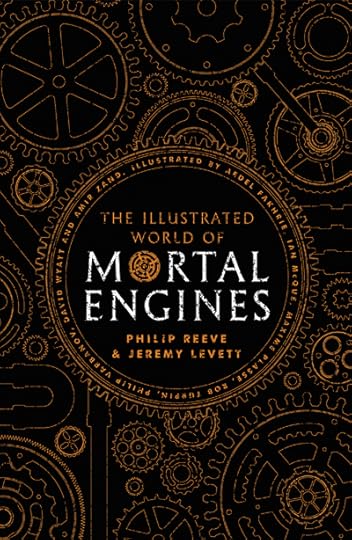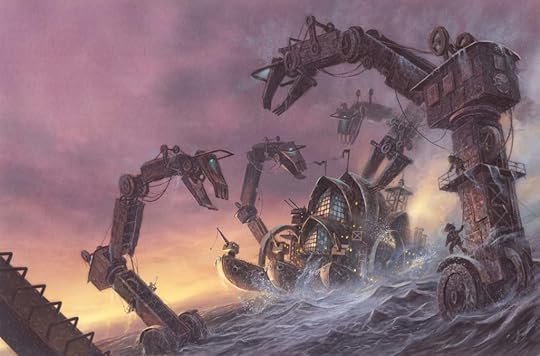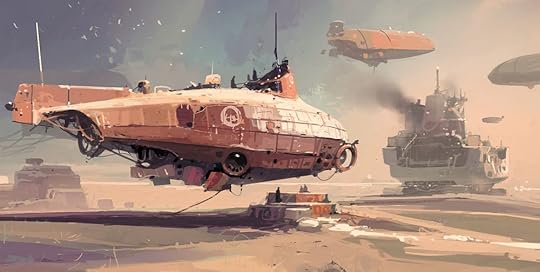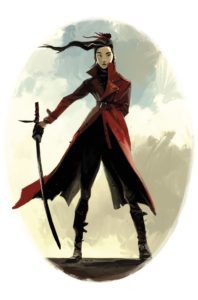An A-Z of the IWOME (Part Three: N–S)

To mark the publication of The Illustrated World of Mortal Engines, my co-author Jeremy Levett has put together an A-Z guide to what it is, how we wrote it, and who did all the lovely artwork. The first part is here, the second is here, and now for the third:
N is for Night Flights…
…the Annathology of Fang short stories illustrated by Ian McQue and released earlier this year.
Night Flights is very much its own thing – most of it came from old stories and ideas Philip had about Anna Fang – but one story, The Teeth of the Sea, drew on an idea that came out of the IWOME *: Fastitocalon, a very peculiarly adapted aquatic predator city. You can see David Wyatt’s gorgeous illustration of Fastitocalon in action here, and another version by Ian McQue in Night Flights itself.

* To give time for all the illustrations, the manuscript for the IWOME was actually finished by autumn 2017 – it’s been difficult keeping a lid on it all this time!
O is for Old-Tech A problem with setting things in the future that refer back to the present is that the present won’t stand still, and episodes of Black Mirror keep coming true. Most of the stuff being dug up in the world of Mortal Engines is old tech right now. Fever Crumb found herself standing on a floor tiled with iPods in Scrivener’s Moon, which is about all they’re useful for now. When Tom first found a CD in Mortal Engines, they were common, but here in 2018 they’re now less popular than vinyl, for some reason. How long until they’ll need explaining to young readers, as if he’d found a VHS or a 5″ floppy disc? (Perhaps this is why the film seems to have replaced it with a toaster…)
A problem with setting things in the future that refer back to the present is that the present won’t stand still, and episodes of Black Mirror keep coming true. Most of the stuff being dug up in the world of Mortal Engines is old tech right now. Fever Crumb found herself standing on a floor tiled with iPods in Scrivener’s Moon, which is about all they’re useful for now. When Tom first found a CD in Mortal Engines, they were common, but here in 2018 they’re now less popular than vinyl, for some reason. How long until they’ll need explaining to young readers, as if he’d found a VHS or a 5″ floppy disc? (Perhaps this is why the film seems to have replaced it with a toaster…)
It’s mad to think about now, but back when the original Codex was written hardly anyone actually had a smartphone, the quintessential Screen Age device. Of course, these feature (our archaeology is bang up to date), but perhaps future editions of the IWOME will have to keep with the times. I’m looking forward to some sort of hands-free brain implant replacing smartphones, which a) will mean no more fiddling around with perishing touchscreen keyboards and b) will neatly explain where Stalker-brains came from…
Some of the Old-Tech actually belongs in the future, and as well as the carefully preserved modern remnants being loaded into the 13th Floor Elevator, you can read about artefacts from lost civilisations like the Electric Empire or the Blue Metal Culture (which everyone seems to think is a reference to some obscure musical movement – it’s really just a civilisation which made lots of things out of an attractive blue metal.)
P is for Maxime PLASSE
…who illustrated all the IWOME’s maps. Maxime has been a role-playing gamer from an early age and always had an interest in fictional worlds, mythology and ancient history; he found his way into graphic design through part-time work for a French RPG publisher, alongside his career as a social worker. He now works full time as a graphic/layout designer and freelance cartographer, working on RPGs, video games, historical magazines and for a range of other clients.
Maxime has a very versatile style, and put all sorts of beautiful details into his IWOME maps: an Aboriginal pointillist pattern surrounding Australia, an Mayan-influenced one for Nuevo Maya. As well as depicting places like south India, Australia and Nuevo Maya, he’s produced a military-style campaign map of the Zagwan Deluge and a lovely, highly stylised representation of the Bird Roads.

You can see his website here and his deviantART page here.
Q is for Ian (Mc)Que
(sssh, it’s a difficult letter.)

Ian McQue was born in Sunderland and worked on the Grand Theft Auto games before becoming a freelance concept artist and illustrator. He now mainly works in the film industry, and lives with his wife and an assortment of cats in rural Scotland.
Ian is one of Philip’s favourite artists, and has worked on covers for the Railhead books as well as illustrating Night Flights and the new set of Mortal Engines covers (you can see some of the new cover art in the IWOME!) Ian has a gorgeous style, filled with stark light and mechanical intricacy, and you can almost feel his cities bearing down on you. As well as giant mechanical things, he’s also very good at character art, and all the little portrait pictures in the IWOME are his work.

You can follow Ian’s twitter here (he shows a splendid appreciation of funny little specialised airport vehicles), find him on Instagram here and buy his artwork here. And if you want to experience his work in a non-Mortal Engines context, give the spookily beautiful game The Signal from Tölva a play.
R is for Realism
Realism is something a lot of people get hung up on, particularly in a science-fiction context, and especially these days now that internet forums allow one to rage to an appreciative audience about how hearing things in space is Stupid, or try to calculate the velocity of an asteroid from how big a half-second explosion in a movie is. This sort of “realism” demands copper-bottomed mathematical working-out of every detail. There’s a place for this – “hard sci-fi” is a popular genre for a reason – but it’s an unhelpful mindset to apply to everything.
I was brought in on the Codex and IWOME partly because I have enough of a reasonable basic engineering knowledge of guns/planes/airships/tanks etc, but the moment scientific reality gets too far in the way of a plot point or a good pun we ignore it, especially if there isn’t a good “OLD-TECH DID IT” handwave.
Something much more important than realism is verisimilitude, in the sense of “internal realism”. The world of Mortal Engines isn’t really a “realistic” one: it’s based around machines that are probably impossible and has immortal cyborg zombies. But it obeys its own internal logic, and, importantly, the humans inside relate to it in a believable way. There are some very, very silly things going on in the IWOME, but it’s not completely implausible that people would think, for instance, that a bouncing city would work (it does for kangaroos!)
S is for Spoilers
How, in a history book where the end of Mortal Engines is one of the more significant events in recent history, do you get around the fact that, well… Mortal Engines has an end? Referring darkly to “the MEDUSA incident” could only get us so far. We ummed and ahhed about how to address the rather important point, and finally decided to take the bull by the horns on the very last page of the IWOME, set against a full two-page rendering of Ian McQue’s cover for A Darkling Plain.
Hopefully, few people who get to the last page of the IWOME will find what’s written there as a surprise – and those that do will go off and read the book to find out how we got there.

 newest »
newest »
 You don't even know how excited I am about all of this.
You don't even know how excited I am about all of this.



